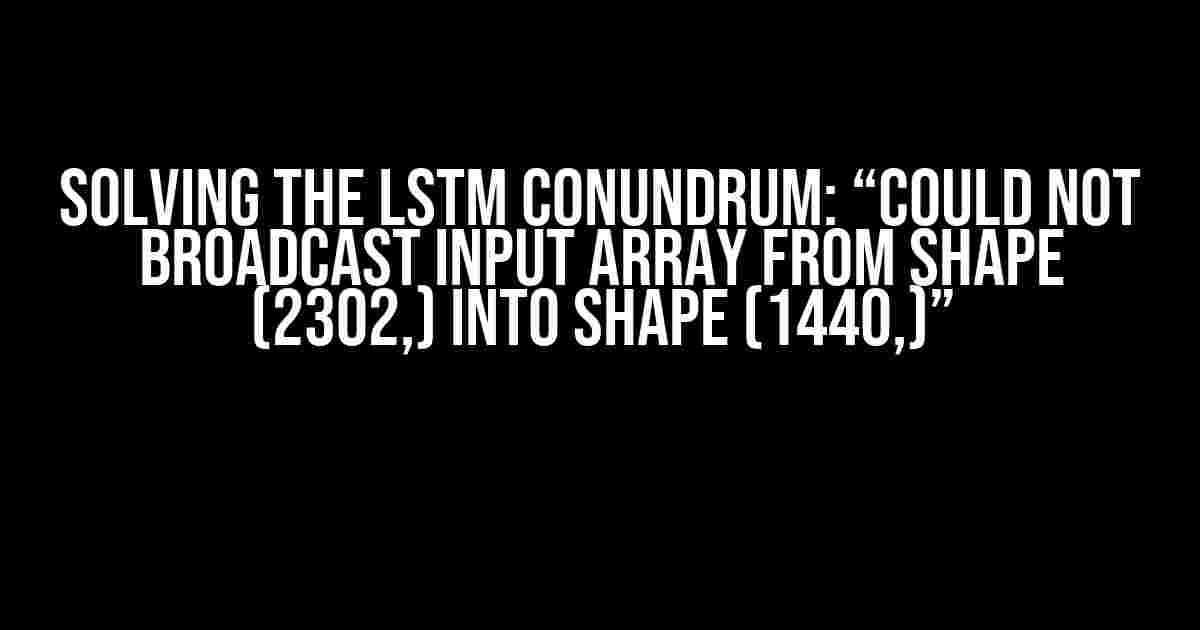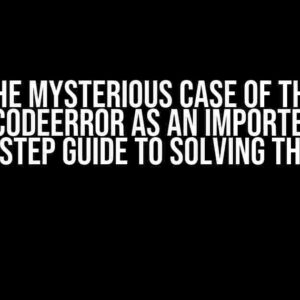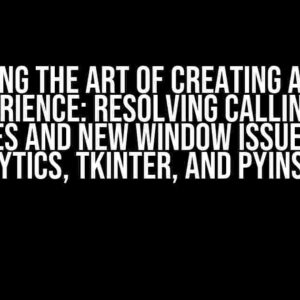Are you tired of encountering the pesky error “LSTM could not broadcast input array from shape (2302,) into shape (1440,)” in your neural network models? Do you find yourself stuck in an endless loop of frustration, wondering what went wrong? Fear not, dear reader, for we have got you covered! In this comprehensive guide, we will delve into the world of Long Short-Term Memory (LSTM) networks and provide you with clear, step-by-step instructions on how to tackle this common issue.
Understanding the LSTM Architecture
Before we dive into the solution, it’s essential to understand the fundamental architecture of LSTM networks. LSTMs are a type of Recurrent Neural Network (RNN) designed to handle sequential data. They consist of three main components:
- Memory Cell (Cell State): This component stores information over long periods, allowing the LSTM to learn from previous experiences.
- Hidden State: This component processes input data and outputs a value that is used to update the memory cell.
- Output Gate: This component takes the hidden state and output from the previous timestep to generate the final output.
The key to understanding how LSTMs work lies in their ability to selectively forget and remember information, making them ideal for modeling temporal relationships in data.
The Error: “Could Not Broadcast Input Array from Shape (2302,) into Shape (1440,)”
Now, let’s get to the heart of the matter – the error message that’s been driving you crazy. The error occurs when the input array’s shape (2302,) cannot be broadcasted into the required shape (1440,) for the LSTM layer. This typically happens when the number of timesteps in the input data does not match the number of timesteps expected by the LSTM layer.
Common Causes of the Error
- Incorrect Input Shape: The input data’s shape does not match the LSTM layer’s expected shape.
- Inconsistent Batch Size: The batch size of the input data does not match the batch size specified in the LSTM layer.
- Missing or Incorrect Padding: The input data is not padded correctly, leading to an mismatch in shape.
Solving the Error: Step-by-Step Instructions
Now that we’ve identified the causes, let’s get to the solution! Follow these steps to resolve the error:
Step 1: Verify Input Data Shape
Check the shape of your input data using the following code:
import numpy as np
# assume 'X' is your input data
print(X.shape)Take note of the shape, as we’ll need it later.
Step 2: Check LSTM Layer Parameters
Inspect the LSTM layer’s parameters using the following code:
from keras.layers import LSTM
lstm_layer = LSTM(units=128, input_shape=(1440,)) # replace with your LSTM layer's parameters
print(lstm_layer.input_shape)Compare the LSTM layer’s expected input shape with your input data’s shape from Step 1.
Step 3: Reshape Input Data (If Necessary)
If the input data’s shape does not match the LSTM layer’s expected shape, you’ll need to reshape it. Use the following code:
X_resized = X.reshape(-1, 1440) # replace with your desired shape
print(X_resized.shape)Verify that the reshaped input data’s shape matches the LSTM layer’s expected shape.
Step 4: Verify Batch Size
Ensure that the batch size of your input data matches the batch size specified in the LSTM layer. You can do this by:
batch_size = 32 # replace with your desired batch size
X_batched = X_resized[:, :batch_size]
print(X_batched.shape)Check that the batched input data’s shape includes the correct batch size.
Step 5: Pad Input Data (If Necessary)
If your input data has varying lengths, you may need to pad it to ensure uniformity. Use the following code:
from keras.preprocessing.sequence import pad_sequences
max_length = 1440 # replace with your desired maximum length
X_padded = pad_sequences(X_batched, maxlen=max_length)
print(X_padded.shape)Verify that the padded input data’s shape matches the LSTM layer’s expected shape.
Additional Tips and Tricks
To avoid encountering this error in the future, keep the following tips in mind:
- Consistent Data Preprocessing: Ensure that your data is consistently preprocessed and has the correct shape before feeding it into the LSTM layer.
- Verify Layer Parameters: Always inspect the LSTM layer’s parameters to ensure they match your input data’s shape.
- Pad Sequences: Use padding to ensure uniform sequence lengths in your input data.
Conclusion
With these step-by-step instructions and additional tips, you should now be equipped to tackle the pesky “LSTM could not broadcast input array from shape (2302,) into shape (1440,)” error. Remember to carefully inspect your input data’s shape, LSTM layer’s parameters, and batch size to ensure a smooth modeling experience. Happy coding!
| Common Causes | Solutions |
|---|---|
| Incorrect Input Shape | Verify input data shape and LSTM layer’s expected shape, then reshape input data if necessary |
| Inconsistent Batch Size | Verify batch size of input data and LSTM layer, then batch input data if necessary |
| Missing or Incorrect Padding | Pad sequences to ensure uniform lengths, then verify padded input data’s shape |
Remember, a well-structured and well-documented guide is essential for tackling complex errors like the “LSTM could not broadcast input array from shape (2302,) into shape (1440,)” error. By following these instructions and incorporating the provided tips, you’ll be well on your way to building robust and accurate LSTM models.
Frequently Asked Question
Got stuck with the LSTM error? Don’t worry, we’ve got you covered! Here are the top 5 FAQs to help you troubleshoot the “LSTM could not broadcast input array from shape (2302,) into shape (1440,)” error:
What does the “LSTM could not broadcast input array” error mean?
This error occurs when the input array has a shape that cannot be broadcasted into the required shape of the LSTM layer. In this case, the input array has a shape of (2302,) but the LSTM layer expects an array of shape (1440,). Broadcasting is a process of reshaping arrays to perform element-wise operations, and the error indicates that this process cannot be done.
Why does the LSTM layer expect a specific input shape?
The LSTM layer expects a specific input shape because it’s designed to process sequential data with a fixed length. The input shape (1440,) indicates that the LSTM layer is expecting 1440 time steps, and each time step has a single feature. The mismatch between the input array shape and the expected shape causes the broadcasting error.
How can I reshape the input array to match the LSTM layer’s expectations?
You can reshape the input array using the `reshape()` function. For example, if you have a 1D array with 2302 elements, you can reshape it to a 2D array with 1440 time steps and 1 feature using `input_array.reshape(-1, 1)`. The `-1` indicates that the number of time steps should be calculated automatically.
What if I have a variable-length input sequence?
If you have a variable-length input sequence, you can pad the sequences to a maximum length using the `pad_sequences()` function from the Keras `preprocessing` module. This will ensure that all input arrays have the same shape, which can be fed into the LSTM layer.
Can I use a different LSTM layer configuration to accommodate the input array shape?
Yes, you can adjust the LSTM layer’s configuration to match the input array shape. For example, you can set the `input_shape` parameter of the LSTM layer to `(None, 1)`, which indicates that the input array has a variable length and a single feature. This way, the LSTM layer can accommodate input arrays with different lengths.




